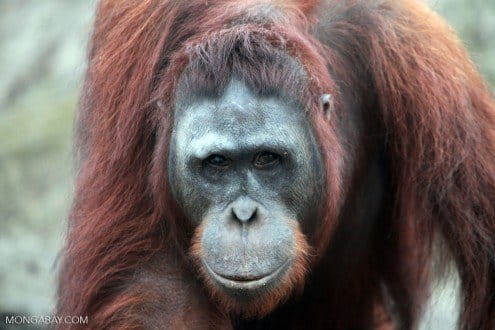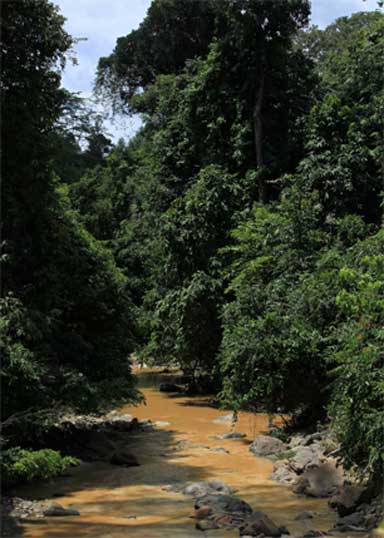- Wildlife corridors are critically important to perpetuating species in a fragmented landscape. Such corridors offer genetic mixing opportunities for large, wide-ranging mammals, especially when they’re trying to mate across vast agricultural landscapes.
- Malaysian oil palm development has devastated the country’s forests. SAFE, a cooperative project between ecologists, the oil palm industry, and a Sabah landowner, is researching the ideal design for functional wildlife corridors within plantations.
- As the Kalabakan River network is being converted to oil palm plantations, scientists will be gathering ongoing data on several existing riverine corridors, with a variety of widths and habitat characteristics, to see which ones work best for wildlife over time.

Five years ago, some 7,000-acres of logged forest in the Kalabakan River network of Sabah, on the island of Borneo, was slated for oil palm production. Imperial College London ecologist Dr. Robert Ewers thought it a good opportunity to study the ecology of human-altered landscapes. “I just wanted to sample a forest before and after it was converted,” he said.
Then, the palm oil company got involved. Ewers set his sights higher, proposing a major scientific study of the land conversion about to occur. The Malaysian palm oil giant, the Sime Darby Foundation, liked the idea and backed Ewers’ research with 30 million ringgit (US $9.8 million). The plan was to document the landscape’s habitat capabilities pre and post plantation — a truly rare opportunity for the study of ecology.
So began the SAFE project, the Stability of Altered Ecosystems initiative.
SAFE is a huge cooperative effort, set up and managed through SEARRP (the Southeast Asian Rainforest Research Partnership), and it operates as part of a suite of major projects in Sabah in collaboration with many research institutions as well as the state government.
SAFE has bold ambitions. When it was launched back in 2011, Mongabay quoted Ewers as saying that his goal was to learn “how we can design the [agro industry] landscape so as to maximize income and minimize environmental cost.”

While the project is a giant scientific undertaking in its entirety, facilitating hundreds of studies and called “the world’s largest ecological experiment,” one of SAFE’s most intriguing focuses is its effort to maintain and study tropical wildlife corridors along rivers as the land is converted. The idea is that these corridors can connect local populations of wildlife, including orangutans that have become isolated by their fragmented habitat.
Readymade Malaysian wildlife corridors
The use of wildlife corridors is a relatively new conservation model born in the last third of the 20th century. These attempts to create continuity between patches of habitat have had a fair success rate the world over — whether protecting free roaming grizzly bears with the Yellowstone-to-Yukon Conservation Initiative in the North American West; conserving the Canada lynx and other wide-ranging Eastern mammals with the Staying Connected Initiative in New England and the Canadian Maritimes; or the ambitious Jaguar Corridor Initiative meant to protect big cats across their range in Latin America.
SAFE is now adding to this model in hopes of determining the ideal characteristics of a first-rate wildlife corridor in Malaysia. What SAFE discovers here could provide very valuable data as agribusiness continues to fragment the region’s once vast, well-connected tropical forests.
The SAFE experiment was made possible by Benta Wawasan, a state company possessing the rights to manage parts of the Kalabakan area for oil palm. For more than thirty years, this riverine forest had been managed mainly for timber by the government, for which forestry regulations require that a riparian buffer, or natural area, be maintained on either side of rivers within the logged area. This prevents soil erosion and protects water quality for the nearby communities downstream.

So when Ewers arrived to begin his work, he found some of the streamside wildlife corridors readymade. And, with the land surrounding them soon to be converted to oil palm, he immediately recognized their potential value. “It’s only now that there’s more attention [being put] to how these rivers can serve as corridors and protect wildlife as well,” he said.
As part of its monitoring process, SAFE is studying these conserved riverine strips to determine the “ideal” size and design of a corridor: one that optimizes unimpaired movement for animals throughout a patchwork agricultural landscape that’s comprised mostly of oil palm.
Ewers’ question concerning ideal corridor design is one that ecologists have grappled with since the 1960s and 70s, through the lens of a variety of species and landscapes. Renowned biologist E.O. Wilson and Robert MacArthur published their seminal work on island biogeography in 1967, showing that species biodiversity and genetic mixing both decrease as an island habitat is made smaller and more isolated (whether that island be a Pacific atoll, Yosemite National Park, or a forest patch surrounded by oil palm plantations). Isolation, researchers found, could eventually lead to complete extinction. Connectivity, however, could foster genetic mixing and offer species resiliency in the face of extreme stressors like habitat loss and climate change.

Today, working wildlife corridors are providing connectivity to cougars in the urban wilds of Santa Monica, California; to isolated populations of threatened red squirrels in the United Kingdom; to mating salamanders in the Champlain Valley of Vermont; and have even led to the construction of multiple Interstate-75 wildlife underpasses to offer safe passage for roaming Florida panthers, bobcats, and black bears.
Designing the ideal orangutan corridor
Each of these species and landscapes, of course, calls for a new definition and new parameters of “ideal” connectivity. This is something that must be determined by place-specific observation and experimentation — but the strongest variable underlying all of these corridors seems to be their width.
“How big is big enough is the million dollar question,” said Paul Biere, a North Arizona University at Flagstaff conservation biologist who has probably studied and designed more wildlife corridors than anyone in the world.
To figure out that ideal width in Sabah’s Kalabakan River network, Ewers is testing out six distinct corridor sizes along the protected riverways.
The first will be very thin: a “zero-meter-wide corridor,” he said, because “it’s important to know if even the tiniest of strips make a difference.” The next size up will be 15-meters-wide, with two more measuring 30 meters — a particularly important study width, he explained, because that is the current width the Roundtable on Sustainable Palm Oil requires companies to preserve when a forest is cut and converted to oil palm. The next size will be 60 meters, and the top sizes will span 120-meters of riverside forest. A few controls will also be monitored, including rivers in forests that remain intact, as well as rivers that lack a riparian zone at all.

Once a corridor strip becomes sufficiently wide enough, wildlife doesn’t just move in and out of it, Ewers explains. Rather, “animals start to set up camp and the area is no longer just a corridor — it’s a habitat.” This is when gene flow between populations becomes continuous, he added, “and that’s the ultimate goal.”
Dr. Matthew Struebig, a lecturer in conservation at the Durrell Institute of Conservation and Ecology (DICE) at the University of Kent, is surveying the already-established river corridors in the oil palm estates that surround the SAFE site. His team is using camera traps to learn which animals utilize these strips of varying sizes as a potential sneak peak into SAFE’s future — work that he’s completing with the assistance of PhD students at DICE under Dr. Henry Bernard from the University of Malaysia Sabah.
Struebig believes that the quality of vegetation within each riparian area is what will or will not ultimately facilitate wildlife movement, an even more important factor than corridor size, he said. “Sure, you can have a large width, but it could all just be scrubby vegetation that’s horrible habitat.”

Given how ecologically trashed some of the landscapes in the Kalabakan network are after being converted for timber, paper, or palm oil production, Struebig said, “I was a bit skeptical if we’d see much biodiversity in the existing corridors.” But much to his surprise, the camera traps are picking up promising images, including “orangutans with infants using the rivers in the middle of palm plantations,” he said, plus other wildlife such as sun bears, a tarsier, and even an elusive flat-headed cat.
In addition to the cameras, Struebig’s team is surveying and identifying indicator species, like dung beetles or birds, which will help tip the team off to the health of that particular ecosystem. “I’m not convinced that orangutans are indicators in this context,” he admitted, but they certainly are flagship animals. “There’s a legal obligation to protect them, so if you see an orangutan in a riparian zone in Indonesia or Malaysia, there is a very strong case for its protection.”
While orangutans are clearly present in the corridors surrounding SAFE’s study area, it remains unknown if they will successfully exchange genes to further their population as agricultural development proceeds. After all, in Sabah, forest fragmentation largely due to agro-industry is now the leading cause of orangutan decline.
For orangutans to be genetically viable, “the minimum size is 200 to 300 animals in a population,” said Hutan Scientific Director Marc Ancrenaz.
This year’s population estimates aren’t out quite yet, but Ancrenaz says it looks like the orangutan population in Sabah is somewhere between 8,000 – 9,000 individuals, which is fewer than the roughly 11,000 orangutans recorded here in 2001, or the 100,000 two centuries ago, he said.

Thanks to lowered deforestation rates, the decline has slowed in Sabah compared to other regions of Borneo, he said, “but obviously these animals need to be able to reach each other, too.” When forests are broken up, this becomes much less likely.
Ancrenaz predicts that scientists won’t be able to tell for another decade or two with certainty whether Sabah’s orangutans are failing to move along the corridors to mate, inbreeding, and thereby degrading their genetic resilience.
Further, orangutans may have a better shot at surviving in a fragmented habitat compared to other wildlife, Ancrenaz revealed. Unlike a beetle or a small mammal, the great apes are quite mobile and can move between patches of forest even if those patches aren’t completely touching. “Not all animals will be able to survive in a patchwork ecosystem,” he said.
The SAFE project is only halfway into its decade-long plan, which Ewers says will probably end up being extended once additional funding is secured. The first steps of selective logging are nearly complete, he reported, and next up is for the ditch diggers to come in to clear out all the remaining stumps and vines in preparation for oil palm production.
Once the surrounding land is cleared, and the experiment’s test river corridors are set up, Ewers said that this river basin will serve as a one-of-a-kind site for studying riparian ecology and biodiversity in Malaysia long-term.

“These kinds of opportunities are very rare,” Struebig added. In fact, it was a similarly rare chance in 1979 that allowed for the landmark long-term Amazon study by conservation biologist Thomas Lovejoy — research that dramatically demonstrated the island effect on diminished biodiversity and helped trigger the scientific rush to create wildlife corridors across the planet.
“As far as I’m aware,” this is the first time anyone has attempted to study the habitat value and biological connectivity of a tropical waterway before-and-after land-use changes, Struebig said. “It will be fascinating to see what turns up over the years.”
SAFE’s comparative results could prove invaluable for determining the ideal design of wildlife corridors in agribusiness landscapes throughout Southeast Asia. Struebig pegs much of the project’s potential to the successful collaboration between ecologists and the local landowner, along with the palm oil company’s significant funding.
They provided a unique laboratory for experimentation, he said, “which will hopefully result in improved oil palm practices long-term.”















